Huron "Beltane" Fire Dance by Loreena McKennitt

Latest News
Welcome to Our New Forums
- Our forums have been upgraded! You can read about this HERE
You are using an out of date browser. It may not display this or other websites correctly.
You should upgrade or use an alternative browser.
You should upgrade or use an alternative browser.
Profile posts Postings About
-
"Retire into thyself. The rational principle which rules has this nature, that it is content with itself when it does what is just, and so secures tranquility."
-Marcus Aurelius
To know what is just, contemplating Satanic Ethics can help you understand. Wouldn't it be lovely if everyone went to bed at night, fully content with themselves, with their actions for the day, having a clear and strong direction in life? Peace of mind, inner fulfillment, bettering the world, raising a better next generation, being close to our GodsFull Moon in Scorpio (after the Void Moon) later today/tomorrow (depending on your time zone, check our SS Calendar for your location).
This is an opportunity to do a working specified towards overcoming any debts you may have, or to improve your investments. As Scorpio also rules other people's money, you can do a working to improve the finances of your spouse, or parent (for those of you who are young and living with parents).
Ordinarily, this would be a good time to do magick for sex, but Mars is currently in Pisces, not a good time for this.
Other good options: transformations, research, surgery, the occultWith Mercury being retrograde now, and Moon will soon be in Virgo, this will be an excellent time to go through your computer documents and reorganize everything:
-Put your pictures in correct files (family, friends, travels, inspiration, etc)
-Go through your downloads and put each item you are keeping into its correct place
-Ensure all your folders make sense, so that you can easily find sub-folders and so on
-Make folders (and subfolders) for your PDFs and order them in the way that is most convenient for you
-Delete anything you don't want to keep
-Backup everything!
You will thank yourself in the future, for the time you spent doing this now Knight of Duatprofound gratitude
Knight of Duatprofound gratitude ️
️ HPS Lydia
HPS Lydia I spent over a solid hour just sorting through my downloads. They are all in correct folders now, some deleted (pics for posts I made, some random things I thought I needed but don't, etc). Even my mind feels more tidy now!
I spent over a solid hour just sorting through my downloads. They are all in correct folders now, some deleted (pics for posts I made, some random things I thought I needed but don't, etc). Even my mind feels more tidy now!
On to my other folders/files now. I made a checklist which helps the reward center of the brain, checking off each task upon completion. I am actually experiencing exhilaration from this, because it is years worth of clutter that I am fixing/tidying, and it will benefit me permanently. Of course there will be more clutter after some time, but the main bulk of it all will be tidy, and I will make sure to organize the new clutter sooner, rather than wait some more years.
And then I will put them all correctly onto my external hard diskTripod Headstand
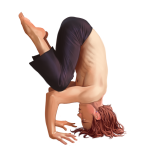
Illustration by @Heather (click to enlarge)
When practicing for the first few times you may want to do this against a wall for support, or in the corner of 2 walls for extra support. Do this on a yoga mat or folded blanket, but not too much padding. You'll need to remain centered on your head and not tip to the side. Make sure to tuck your shirt in if needed, to prevent it from falling in your face and restricting your breathing.
Begin on your hands and knees, keeping your hands at shoulder distance apart. Place the top of your head on the floor. You will essentially form a triangle from your hands to your head at the apex. Keep arms bent at 90 degree angle with palms flat on the floor, elbows over wrists and in line with your shoulders. Keep your neck long. Do not allow your shoulders to sag to your ears. Engage your core (abs).
Lift your hips and knees so you are on your toes, carefully walk your feet towards your hands until your knees can be placed on your triceps. Lift your feet to match the illustration above, then press your big toes together. Remain here as long as is comfortable.
To exit: bring your feet down, then bring your head up. Remain in child's pose for a few moments to allow your blood to circulate properly (preventing headrush).
Full extension of the above pose: From the above (as shown in the illustration), bring your heels towards your glutes, activate your core, activate your legs and extend them upwards. Keeping your core activated will stabilize your balance. Push down through your arms to take pressure off your neck, and prevent your shoulders from sagging to your ears.
To exit: bend your hips and knees, place knees back on triceps then bring your feet to the floor. Remain in child's pose for a few moments to allow your blood to circulate properly (preventing headrush).
Benefits: helps with cores strength, increases coordination, builds confidence simply by learning an inversion.
A good tip for learning headstands: Sit and/or walk with a heavy book balancing on your head. This will train your neck to be long, instead of tucking your chin or arching your neck; and you become used to the feeling of having pressure on your head. SonneI thought the person in the picture was real for a moment."For the goal is not to lose one’s self when improving the world, but to also improve the self and others as part of this greater and eternal world." [...] “It is only by improving the world, that you will improve yourself. It is only by improving yourself, that you will improve the world – for infinity can only flow again back into infinity.”
SonneI thought the person in the picture was real for a moment."For the goal is not to lose one’s self when improving the world, but to also improve the self and others as part of this greater and eternal world." [...] “It is only by improving the world, that you will improve yourself. It is only by improving yourself, that you will improve the world – for infinity can only flow again back into infinity.”
- Azazel's Virtue, World ImprovementAangramainyu. Discarding all of the Jew talk disinformation,,, is there something BIG going to happen with all of these ''coincidental'' events at the same time.? This man is talking Astrology, of course,,, he won't tell us this, but we know the truth. Does Satan have anything to say about this ?Moon square can be started tonight! Remember that the squares are not for beginners and all chakras must be properly opened. You might want to do the short version of the mantra, as the long version can take a full hour of your time for some days.
 HPS Lydia
HPS Lydia @Shiva666 All chakras need to be open to do the squares properly. And the Moon square has a lot of repetitions which could be too much for beginners. Another reason is that working too much on psychic related workings could cause beginners to become unstable. It could be fine for some beginners, but as a general precaution I'd advise to do lighter workings, as the Moon square is very powerful.Yoga Asana: Adho Mukha Svanasana (Downward Facing Dog)
@Shiva666 All chakras need to be open to do the squares properly. And the Moon square has a lot of repetitions which could be too much for beginners. Another reason is that working too much on psychic related workings could cause beginners to become unstable. It could be fine for some beginners, but as a general precaution I'd advise to do lighter workings, as the Moon square is very powerful.Yoga Asana: Adho Mukha Svanasana (Downward Facing Dog)

Illustration by @Ardgion (click to enlarge)
Begin on all fours, your hands under your shoulders and your knees under your hips. Have your hands shoulder-width apart (by placing them directly under your shoulders), and your knees and feet about a foot apart, or slightly more if this is better for your body.
Lift your hips up, keep your legs engaged. Feel a stretch from your arms through your shoulders and back, and another from your feet up to your glutes. Keep your core engaged (do not let your belly hang), and relax the neck.
To warm up the tendons in the ankles, you can alternate pressing one down more while coming up on the balls under the toes of the other, and switch (called peddling the feet). Do a few rounds of this to gain flexibility, then press both heels into the floor. (It can take a few years of practice to get both heels on the floor so don't worry if your heels don't reach yet.)
If you would like a further stretch, move your left foot into the center line and lift the right leg straight up as high as possible, keeping balance on both hands and left foot. Bend the knee to bring the right foot towards the left hip, remain here for a few seconds or longer. Bring that leg down, placing the right foot next to the left foot and repeat on the other side; and then go into the proper pose with your feet about 12 inches apart. I find doing this helps to increase the flexibility of the ankles to allow for both heels to press into the floor more firmly.
Remain in this pose for as long as comfortable, breathing deeply.
To release, lower your knees to the floor and come out of the pose.
Benefits: Alleviates fatigue, reinvigorates the body, balances the energy of the body between upper and lower body, strengthens ankles, removes stiffness in the area of the shoulder blades.Hps Lydia, if you were to recommend one or more "stand-alone" asanas to balance the sun and moon channels, what would they be?
 HPS Lydia
HPS Lydia Prayer mudra, perhaps incorporate it into siddhasana or cobbler's pose.
Prayer mudra, perhaps incorporate it into siddhasana or cobbler's pose.
I've seen a picture of someone doing prayer mudra while in headstand, palms behind her back. That's more advanced though, as the hands are obviously not used for balance.
Also try downward facing dog that I just posted, hold it for longer and concentrate on it balancing the channels. GoldenxChild1Thank-you, milady"Yoga is the journey of the self, through the self, to the self."
GoldenxChild1Thank-you, milady"Yoga is the journey of the self, through the self, to the self."
-The Bhagavad Gita existentialcrisisI love the Bhagavad Gita. It feels centering to read.
existentialcrisisI love the Bhagavad Gita. It feels centering to read. Cosmic6999How explain please"Yoga does not just change the way we see things, it transforms the person who sees."
Cosmic6999How explain please"Yoga does not just change the way we see things, it transforms the person who sees."
-BKS IyengarYoga Asana: Parighasana (Gate Pose)
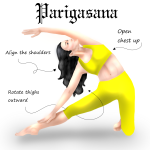
Illustration by @Rroco88 (click to enlarge)
Start by kneeling on the floor. Bring your right leg to the side, stretched out. Right foot should be in line with the left knee. Turn the right foot out at a comfortable angle for your ankle. Extend arms sideways. Inhale, and on the exhale bend to the right, move your right hand along your right leg as you bend. With practice, your right forearm will be along your right shin.
Bring your left arm overhead and also to the right if possible (or just have straight up for now). Keep your chest open and breath normally. Keep your right leg engaged and not just limp.
With more practice, you will be able to place your left pam to your right palm and lean over your right leg fully.
To release: Inhale, then exhale and rise up, place right leg back into kneeling position. Repeat on the other side.
Benefits: The pelvic region is stretched and gains fresh blood flow; improves the health of the organs; alleviates stiffness in the back and hips.Ive been wondering why i havent seen more of your posts, are you planning to keep it posting on your profile and let the page posts to HPHC? HPS Lydia
HPS Lydia I will continue, I had to tend to other things for a short while. I'm balancing multiple projects for the JoSYoga Asana: Sirsasana (Headstand)
I will continue, I had to tend to other things for a short while. I'm balancing multiple projects for the JoSYoga Asana: Sirsasana (Headstand)

Illustration by @Heather
There are quite a few headstand variations, these are very beneficial to practice but I'll just post one for now. The JoS will later have illustrations for methods to get into these poses.
BKS Iyengar states that when in proper form of the headstand, “This brings a feeling of lightness to the brain and complete relaxation to each part of the body.” However, if this pose is done daily without also performing the complimentary shoulder stand daily, it can aggravate feelings of impatience and irritation.
I love to start my asana practice with headstand, as it immediately increases my mental clarity and focus in preparation for the rest of my practice. (I end my practice with shoulder stand followed by plow pose, then roll out to shavasana.) However, for those who have high or low blood pressure, it is not advised to begin your yoga practice in this pose; you can perform it near the end of your practice instead.
My notes on the easiest way to learn this asana is to do it in a corner, where two walls will support you evenly, preventing you from falling to either side. Have suitable padding under your head, not a pillow, but a blanket or yoga mat folded evenly. If your padding is too cushioned it can make you uneven and thereby cause injury to your neck.
Tip to ensure your elbows are the the correct distance apart: hold each elbow with the opposite hand, your forearms will be along each other. You can then place your elbows on the floor, and rotate your hands and forearms to put them into position, as shown in the videos linked. Make sure to keep your core engaged, as well as your glutes and legs.
Instructional video, with variations A & B, feel free to do this against a wall or a corner for additional safety:
Instructional video against a wall (ignore the mantra):
Benefits: Improves memory, increases the health of the physical brain (including the pineal gland). Lungs are strengthened. And like in all asanas: the mind is disciplined. SonneI used to do that a lot when I was little, I didn't know what it did though, but I think it felt very good.
SonneI used to do that a lot when I was little, I didn't know what it did though, but I think it felt very good.
Thank you, High Priestess Lydia!Yoga Tips:
For all asanas, keep distance between your limbs comfortable for you. Recognize that your individual body is your own and you might need more or less distance between your feet, etc.
Never push yourself beyond your comfort. Always modify for your body if needed.
Always keep your core engaged (do not let your belly hang) unless otherwise stated.
(This post is a work in progress and will be updated along the way, and then transferred to the JoS when complete.) balo666Shouldnt we push ourselves even a little bit during asanas? im not talking about athletic stretches, but putting some pressure on oneself. I started yoga more than 2 years ago and i constaly practice it, but after some point, totally relaxed asanas calm my nervious system of course but they dont help me to surpass my previous limits. Should one practice both?
balo666Shouldnt we push ourselves even a little bit during asanas? im not talking about athletic stretches, but putting some pressure on oneself. I started yoga more than 2 years ago and i constaly practice it, but after some point, totally relaxed asanas calm my nervious system of course but they dont help me to surpass my previous limits. Should one practice both? HPS Lydia
HPS Lydia Yes, push yourself as far as it feels correct to do so, but not more. I vary my practice, I do more relaxing when I need it, and more challenging at other times.Yoga Asana of the Day: Virabhadrasana II (Warrior 2)
Yes, push yourself as far as it feels correct to do so, but not more. I vary my practice, I do more relaxing when I need it, and more challenging at other times.Yoga Asana of the Day: Virabhadrasana II (Warrior 2)
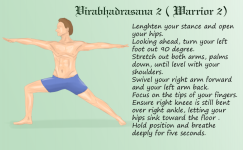
Illustration by @Ardgion
Standing in Mountain Pose, spread your feet approximately 4 feet (48 inches) apart to the sides, arms straight out at shoulder height, palms facing down. Turn the right foot 90 degrees to the right, and left foot slightly to the right. (Alternatively, you can begin from Mountain Pose by stepping the left foot back by 4 feet and turning the left foot slightly outwards, keep the right foot where it is.) Keep your entire left leg engaged and knee tightened. Inhale, and on the exhale bend the right knee so the thigh is parallel to the floor, forming a right angle from your thigh to your shin. Do not bring your right knee in front of the toes, keep it above the heel.
Keep your arms straight as in the illustration, feel a stretch across the shoulders and chest. Face your right palm. Keep your shoulders in line with your hips and fully open. Feel strength in your hips, and a balance of your shoulders being above your hips. Keep your core engaged. Remain in this pose for up to 30 seconds with deep breathing.
To do the other side: From the above, straighten your right leg, pivot on your feet so your left leg is now in front yet your chest is still facing the same direction; repeat all instructions for the left side. To finish, relax your arms, straighten your legs and return to Mountain Pose.
Benefits: This pose strengthens the legs and prevents/treats leg cramps. It is relieving for the back.Yoga Asana of the day: Urdhva Mukha Svanasana (Upward Facing Dog)

Illustration by @Heather (click to enlarge)
Begin lying on stomach. Feet are about one foot apart with toes pointing straight back. Place your palms on each side of your waist with fingers pointing forward (to your head). Inhale and raise your head and torso like you are going into cobra pose, but also raise your pelvis and thighs, keeping your knees off the floor. Keep your glutes and legs engaged, your weight will be on your hands and toes (the tops of your toes which are pressing into the floor, as shown in the illustration above). Press your chest forwards.
Feel a stretch through your chest, abdominals, and entire legs. Have your head back at a comfortable position for you. Your arms will be fully engaged to support your weight. Stay in this pose as long as comfortable, breathing deeply.
To release, bend your elbows and relax your legs then your torso onto the floor.
Benefits: This pose is very healthy for the spine and back, and treats sciatica and lumbago. The lungs are expanded, and blood circulation is brought to the pelvic region. Henu the GreatA quite comfortable asana.Yoga Asana of the day: Prasarita Padottanasana
Henu the GreatA quite comfortable asana.Yoga Asana of the day: Prasarita Padottanasana
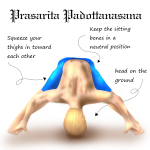
Illustration by @Rroco88 (click to enlarge)
Stand with your feet between 4-5 feet apart, at a comfortable width for you. Inhale, place hands on waist and stretch your chest up. Exhale as you lean forward at the hips and lower your torso and head, place your hands on the floor in front of you for balance only, keep your weight entirely on your feet. Inhale, keeping hands on the floor, straighten your back and lift your chest and shoulders up to make your lower back concave; exhale and lean forward and down again, hinging at your hips. If your head is able to touch the floor, do not place bodyweight on it; keep your weight entirely on your feet.
You can remain with your palms on the floor, but if possible, hook your pointer and middle fingers and thumbs around the big toe of the corresponding foot, as shown in the illustration. Gently draw your elbows out to deepen the pose. Do not clench your glutes, but keep your thighs activated and drawing together.
Benefits: The hamstrings receive a nice stretch and the hips are open. Blood can circulate to the head, so this is beneficial for those who cannot yet perform headstand or handstand. This pose helps to increase balance.Yoga Asana of the Day: Parsvottanasana (Pyramid Pose)
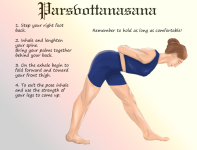
Illustration by @Ardgion (click to enlarge)
Begin standing in Mountain Pose (just standing, feet together). Roll your shoulders back, keep them relaxed yet shoulder blades close together, down from the neck (not hunched up). Bring your elbows back and if possible, press your palms together in prayer mudra behind your back. If this is not possible, then simply hold your hands together behind your back.
Step the left leg back, about 1 meter behind you. The left foot can point out slightly at a comfortable angle for you. Keep both knees activated. Inhale, make sure your shoulders and arms are in correct position, exhale and lean forwards over your right leg. If you have the flexibility you can lower your head to your knee or shin, and remain like this for as long as comfortable; if you are newer to this pose, you can now relax your arms and touch the floor with your hands (or place your hands on your leg for support), enjoying the stretch in your front hamstring.
To release, raise up by using your leg muscles firmly, step your left leg forward to meet the right, and repeat on the opposite side (right leg back).
Benefits: This asana is beneficial for the legs and hips, and gives a nice stretch to the shoulders and front of the armpit area. It helps straighten rounding or drooping shoulders. If you are able to reach your face to your knee/leg and pressing your abdominals into your thigh, then this benefits your digestive organs.Yoga Asana of the day: Padmasana
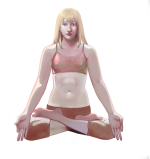
Illustration by @Heather (click to enlarge)
Start in a seated position, legs in front of you. Bend the right leg and use your hands to place the foot at the top of the left thigh, the heel should be near the navel and the sole will be facing up. Bend the left leg and use your hands to place your left foot over the right, also at the top of the thigh with the heel near the navel and the sole facing up. Remain in the position as comfortable with the back erect, then release the legs, gently move them around, and repeat with the legs reversed (left leg first).
Hands can be on knees with fingers in Gyan mudra, or palms facing up (one hand in the other) in the middle of where your feet cross.
This can be difficult at first to perform, and takes time for the knees and hips to gain the needed flexibility. Practicing the various pigeon poses and other hip-opening asanas will help prepare the hips for this pose. Never strain your knees, think of this asana as a long-term goal, even if it takes a few years of practice. In the beginning, practice with one leg at a time, with the other remaining straight out or bent, however is comfortable for your body; and then repeat on the other side.
Benefits: This asana is beneficial for those who are heavy in the Earth element or otherwise feel stagnant and heavy (Kapha); it will help you reach a lighter and higher state of meditation. Padmasana when correctly performed helps the kundalini energy reach the Crown chakra. This asana is beneficial for the knees and ankles, spine, lumbar region, abdomen.Yoga Asana of the day: Ardha Chandrasana (Half Moon Pose)
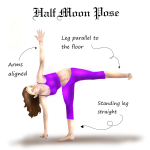
Illustration by @Rroco88 (click to enlarge)
For those with less experience:
You can do this against a wall, keeping your hip of the balancing leg gently pressing into the wall. You can also use a block or large book to place your hand upon, until you are able to reach the floor.
Stand against a wall, with your right hip/buttock touching the wall, face out by 45 degrees, with your right foot parallel to the wall but approximately 3-6 inches out (depending on the size of your hips and thighs, adjust to your comfort). Slide your right shoulder and arm down while keeping your torso straight; press the outside of your forearm into the wall for added support. Simultaneously lift your left leg keeping it in a line with your torso, reach your right arm down, touch the block or the floor with your right fingertips until you are able to reach with your palm, but do not place any bodyweight onto your hand, it is only there for balance.
Feel your left leg engaged, use your left hip to keep the leg horizontal. Left arm can be against your side with the hand on hip or thigh, or lift it upwards. Keep your back straight, chest open, and lifted leg stretched straight. Your weight should be fully on your balancing foot (the foot that is on the ground).
Stay for as long as is comfortable, then exhale and stand up again. Repeat on the other side.
For those with more experience:
You can get into this pose from triangle pose (Trikonasana) by bending the knee of the front leg and shifting your weight onto it as you move your hand about 12 inches forward in line with your front foot, straightening the front leg as you lift the back leg up. You can place the top arm against your body so the hand is on your hip, and then when balance is comfortable, raise your hand upwards as in the illustration. The hand that is on the floor is only for balance, do not place your bodyweight on it.
To get out of the pose, you can reverse your movements back into Trikonasana then stand up; repeat on the other side.
Benefits: This pose is very healthy for the lower spine, and for the nerves connecting to the leg muscles. As this pose is so different from the usual movements we do in our day, you might feel exhilarated upon coming out of the pose. Henu the GreatI think that image could be improved. Look here how core alignment looks more like a straight line in all directions. https://s1.qwant.com/thumbr/0x380/1...rdha-Chandrasana-1024x908.jpg&q=0&b=1&p=0&a=0
Henu the GreatI think that image could be improved. Look here how core alignment looks more like a straight line in all directions. https://s1.qwant.com/thumbr/0x380/1...rdha-Chandrasana-1024x908.jpg&q=0&b=1&p=0&a=0 Henu the GreatAnd thanks for the asana. Looking for something specific for a specific issue.
Henu the GreatAnd thanks for the asana. Looking for something specific for a specific issue. ArdgionGood thing to note Henu! I totally missed that as well.Here's a lovely rendition of "The Fields of Athenry". This song takes place during the Great Famine. It's about a father who stole food to feed his child, he was caught and shipped off in a prison ship to a penal colony in Australia (a typical plight for many Irish during that time). The enemy has done much evil to our people.
ArdgionGood thing to note Henu! I totally missed that as well.Here's a lovely rendition of "The Fields of Athenry". This song takes place during the Great Famine. It's about a father who stole food to feed his child, he was caught and shipped off in a prison ship to a penal colony in Australia (a typical plight for many Irish during that time). The enemy has done much evil to our people.
 ArdgionBeautiful song, thank you for sharing!Yoga Asana of the day: Virasana (Hero Pose)
ArdgionBeautiful song, thank you for sharing!Yoga Asana of the day: Virasana (Hero Pose)
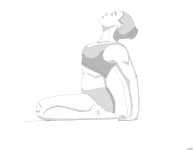
Illustration by @Ardgion (click to enlarge)
[Do not attempt this pose if you have a knee injury. Always consult a yoga instructor to see if a pose is safe for you to do. To modify if your knees are weak or you are overweight: keep your hands on the floor on each side of your body or in front of your knees to support most of your bodyweight and gently ease into the pose, and have a cushion between your feet to sit on. Holding for even a split second will bring benefit to your knees, and you can gradually build up the length of time. You can also simply sit on your feet but with your feet slightly wider than your knees to gain the benefits of this pose.]
Kneel on floor, keeping your knees and thighs together; separate your feet by about 18 inches. As you begin to lower your body, take your calf muscles and roll them outwards, to make room for your thighs to lower between your calves. Your hips will be between your feet, and your inner calf will be touching the outer thigh of the same leg.
You probably won't be able to lower all the way at first, it can take a year or more to gain the needed flexibility. Your toes might angle in at first, but over time, the toes will be able to point back.
Keep your hands on the floor on each side of your body if necessary. In time, you can have your hands on your knees in in Gyan mudra, or keep your palms on your knees, as shown in the illustration below:
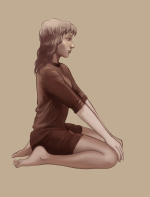
Illustration by @Heather (click to enlarge)
If you are able to sit on the floor, you can then place your hands behind you as in the illustration above and reach your chest upwards. This will help prepare for the extended version of this asana (Supta Virasana).
To get out of this asana: lean forward, place your hands on the floor beside or in front of you, ease up onto your knees and bring your feet together, then stand or sit up.
This asana is very beneficial for the knees and heels. Practiced long-term, it helps treat flat feet be developing the arches of the soles. This is one of the few asanas that can be practiced immediately after eating, it will help digest a full meal, alleviating the heavy feeling in the stomach.
Once you have mastered the above, you can then place a low chair or table behind you to prepare for the full extended version. Use as many cushions or props as necessary for your comfort. The illustration below is leading into the full version (Supta Virasana), which will be posted at a later time:
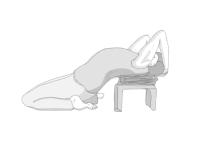
Illustration by @Ardgion (click to enlarge) AristocraticDragon666Lydia, hi
AristocraticDragon666Lydia, hi
I want to share with you my Digital Art, these beautiful owls:


I will also post them in my "Profile posts".
 phi3.14infinityMore like owl cake
phi3.14infinityMore like owl cake Yoga Asana of the Day: Utthita Parsvakonasana (Extended Side Angle Pose)
Yoga Asana of the Day: Utthita Parsvakonasana (Extended Side Angle Pose)
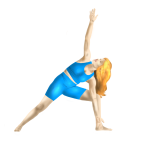
Illustration by @Rroco88 (click to enlarge)
Stand with your feet approximately 4 feet apart. Turn the right foot sideways to the right by 90 degrees, and the left foot slightly to the right, at a comfortable position. Bend the right leg to form a 90 degree angle, your thigh will be parallel to the floor. Keep the left leg stretched and tight at the knee. The right arm can be in front of the bent leg, or behind with the knee near the armpit, whichever works best for your body. If you can, place your right palm on the floor, or only touch the floor or your ankle with your fingertips.
The forearm should be pressing into the lower leg of the bent leg, this will give the stability to extend through the chest, shoulders, and raised arm. (If you are lacking flexibility, you can rest your right forearm on your right thigh for practice.) The extended left arm can be straight up as in the illustration above, or it can reach above your head to form a straight line with the extended leg.
Keep your chest full, don't cave it in. Your core should be engaged. Feel a stretch through your entire body. Hold for as long as comfortable, keep your breathing steady. Relax, and repeat on the other side.
This pose relieves sciatic pain and stretches the entire body, especially the inner thigh of the bent leg, and tones the ankles, knees, and thighs. Henu the GreatFeels good, is easy to do, and fits midst of other asanas I routinely do. In conclusion, accepted into the bunch.Yoga Asana of the Day: Mahamudra (also known as Maha Mudra)
Henu the GreatFeels good, is easy to do, and fits midst of other asanas I routinely do. In conclusion, accepted into the bunch.Yoga Asana of the Day: Mahamudra (also known as Maha Mudra)
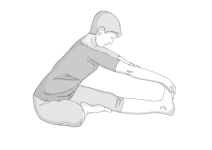
Illustration by @Ardgion (click to enlarge)
Maha means great, noble; mudra means seal. In the Hatha Yoga Pradipika, this asana is said to "destroy death and many other pains", and cures all digestive complaints.
Start by sitting on the floor. Bend the knee of one leg and place the sole of the foot against the inner thigh of the extended leg, try to get the heal near the perineum if possible. The angle of the extended leg and the thigh of the bent leg should be at 90 degrees. Keep the extended leg engaged, don't let it flop to the side.
Have your back straight and core engaged (don't let your belly sag), and reach forward, place your hands on your knee or shin if you lack flexibility. If you can, hold the big toe of your extended leg with the thumb and forefingers of both hands. Pull your abdomen in and tighten it upwards to your diaphragm. You can round your back to get the stretch of the hamstring, but the full asana requires this to be done with a straight back. Hold for as long as comfortable. Repeat on other side.
[The advanced full version is to apply chin lock and root lock, thus creating the seal.]
This asana helps with spleen problems, enlarged prostate, and improves digestion. It is beneficial for women who have a prolapsed uterus. HPS Lydia
HPS Lydia BKS Iyengar writes* to inhale, do chin lock first then root lock, hold as long as comfortable, release and exhale. You can repeat throughout the duration of the asana.
BKS Iyengar writes* to inhale, do chin lock first then root lock, hold as long as comfortable, release and exhale. You can repeat throughout the duration of the asana.
I've tried both ways (root lock first; also engaging both at the same time) and I do agree with Iyengar's method, as it seems to set the seal correctly.
*Light on Yoga; this book is easily found anywhere as it is very popular. I highly recommend it. (I have other books of his plus other resources and my own experiences that I use for these posts.) AFODOWait I realized: I was reading Shiva Samhita yesterday, and Mahamudra was described a bit differently. It said, to put your heels between your anus and genital (where the base chakra is) so essentially you are pushing the base chakra with your heel. The foot is still in this tilted position so you are basically sitting on the side of the heel. Start with sitting on the left heel and put the right leg straight, than vice versa.
AFODOWait I realized: I was reading Shiva Samhita yesterday, and Mahamudra was described a bit differently. It said, to put your heels between your anus and genital (where the base chakra is) so essentially you are pushing the base chakra with your heel. The foot is still in this tilted position so you are basically sitting on the side of the heel. Start with sitting on the left heel and put the right leg straight, than vice versa.
Maybe the version on your post is also effective, and I think the Shiva Samhita version is more advanced. HPS Lydia
HPS Lydia There are different versions to many of the asanas. I am posting the main version for this series. I don't have the time to write on other versions as there are other priorities I need to focus on, but at some point in the future I probably will, unless other members do.Yoga Asana of the Day: Malasana 2 (Garland pose)
There are different versions to many of the asanas. I am posting the main version for this series. I don't have the time to write on other versions as there are other priorities I need to focus on, but at some point in the future I probably will, unless other members do.Yoga Asana of the Day: Malasana 2 (Garland pose)
Soles of the feet should preferably be on the floor, but if you can only do this on the balls and toes of your feet this is fine for practice until your ankles become more flexible. If you have bad balance, you can do this with your back/glutes against the wall: squat against a wall and shuffle into position, keep feet together (preferable) or slightly apart (modification); or you can face the back of a sturdy chair and hold onto it for support. You can have a block or rolled up towel/blanket under your heels if your ankles are stiff or weak.
Start from standing with feet together, squat down and find your balance; or start from a squat position from a previous seated position if this works better for you. Widen your knees while keeping your feet still together, exhale and lower your arms and core forward between your legs, your armpits will be in front of your knees. Place hands on the floor. Wrap your hands to hold onto the back of your ankles or heels. You can look ahead, or lower your body more to eventually reach your head to the floor.
[With increased practice you will be able to wrap your hands behind your back, clasping your fingers; this is Malasana 1.]
Another variation is to have feet wider apart (feet preferably parallel, or toes slightly turned out), place hands into prayer pose with your upper arms or elbows pressing into your inner thighs. This will give a nice stretch to the inner thighs and groin. You can sit on a block or pillow for this one, if you need the assistance.
This pose (all versions) increases circulation to the sex organs; can benefit men suffering from ED or testicular problems; can benefit women suffering from menstrual complaints; strengthens the pelvis; benefits the colon. Helps give relief to the lower back, helps tone the ankles. Gives a nice stretch to the shoulders. Helps prevent/treat constipation and urinary problems, as it regulates the correct energetic movements that contribute to proper excretion (Apan Vayu). Henu the GreatGood, keep em' coming!Yoga Asana of the day: Utkatasana (Chair pose)
Henu the GreatGood, keep em' coming!Yoga Asana of the day: Utkatasana (Chair pose)
Stand straight in Mountain Pose, legs and feet together. Lift arms overhead and place palms together (they can remain apart if this is more comfortable for your shoulders). Exhale and bend your knees, keeping your thighs and knees firmly together. Try to get your thighs parallel to the floor, but this will take practice. Keep your back straight and chest expanded, do not slump your upper body or arch your lower back. Keep your core engaged, do not allow the belly to sag. Feel strong in your heels.
This asana helps the knees and ankles become strong and toned, and fixes minor knee complaints. It alleviates stiffness in the shoulders and strengthens the leg muscles. Carolina666Thank you very much sister. This new forum looks wonderful!!!Yoga Asana of the day: Siddhasana
Carolina666Thank you very much sister. This new forum looks wonderful!!!Yoga Asana of the day: Siddhasana
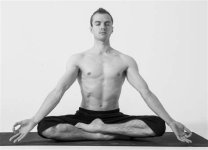
From a seated position, bend one leg and place the heal near your perineum (genital area). Bend the other leg placing that foot above the other, against the pubic bone. If you are less flexible, approximate the best you can. Keep your torso engaged and strong, have your back straight yet with its natural curvatures, and shoulders relaxed yet not slumped. You should feel a balance of your shoulders above your hips. Place your hands on your knees in the mudra as shown in the picture. Do not lean against a wall or anything, as this will prevent the correct balance and the mental sensation that comes with it. Do this seated on the floor, your balance will be off if you are on a bed mattress.
Holding for 3 minutes is ideal, less is fine. Holding any asana even for a few seconds will benefit you, and help to build your ability to hold for longer. Release the legs, gently move them to release any tension, then do the same pose with the leg positions reversed and hold for the same length of time.
This pose helps with all nerve defects and nervous conditions, increases focus, and brings a sensation of wellbeing. It increases health of the genital area and the lumbar region. This is a great asana to do somewhere in the middle of a long hatha practice as it will restore your vitality to continue with the rest of your practice, or you can do this separate from hatha while meditating and while doing pranayama.
This is one of the easiest, yet one of the greatest, asanas to do. Sit in this posture while contemplating the Gods. HPS Lydia
HPS Lydia A member messaged me. Where I wrote about not using a wall for support in this pose, it is only for practicing this as an asana. You can definitely use a wall or bed for support for any other time, I certainly do, as it makes it much easier to meditate if we are physically comfortable.Yoga Asana of the day: Virabhadrasana I (Warrior 1)
A member messaged me. Where I wrote about not using a wall for support in this pose, it is only for practicing this as an asana. You can definitely use a wall or bed for support for any other time, I certainly do, as it makes it much easier to meditate if we are physically comfortable.Yoga Asana of the day: Virabhadrasana I (Warrior 1)
Increases will power and sensation of having a strong foundation. Strengthens legs, glutes, hip flexors. Very good for sciatica. Helps with deep breathing, strengthens ankles and knees.
Feel your feet pushing firmly into the ground, lifting the rest of your body upwards, feel strength through your torso and keep your core engaged (don't let your belly hang). Feel a stretch in the back leg. Hold your gaze steady, breathe long and deep if possible. Relax out of it, repeat on the opposite side.
Can put strain on the physical heart, so it is advised to avoid or modify for those with heart conditions. Modification can be done by keeping hands apart while looking straight ahead, or hands in prayer mudra in front of your chest, and hold pose for only a few seconds. Iyengar suggests people hold this post for only 20 to 30 seconds regardless as it is strenuous (if you are in the pose correctly). balo666This is great, since some weeks i started doing some of the warrior positions just right after i wake up, could you do more publications for warrior positions?
balo666This is great, since some weeks i started doing some of the warrior positions just right after i wake up, could you do more publications for warrior positions? -
Loading…
-
Loading…
Al Jilwah: Chapter IV
"It is my desire that all my followers unite in a bond of unity, lest those who are without prevail against them." - Satan



Reactions: Sonne and HPS Lydia